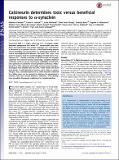Calcineurin determines toxic versus beneficial responses to α-synuclein
Author(s)
Caraveo, Gabriela; Baru, Valeriya; Lindquist, Susan; Auluck, Pavan K.; Whitesell, Luke; Chung, Chee Yeun; Mosharov, Eugene V.; Yan, Xiohui; Ben-Johny, Manu; Soste, Martin; Picotti, Paola; Kim, Hanna; Caldwell, Kim A.; Caldwell, Guy A.; Sulzer, David; Yue, David T.; ... Show more Show less
DownloadCaraveo-2014-Calcineurin determin.pdf (1.677Mb)
PUBLISHER_POLICY
Publisher Policy
Article is made available in accordance with the publisher's policy and may be subject to US copyright law. Please refer to the publisher's site for terms of use.
Terms of use
Metadata
Show full item recordAbstract
Calcineurin (CN) is a highly conserved Ca[superscript 2+]–calmodulin (CaM)-dependent phosphatase that senses Ca[superscript 2+] concentrations and transduces that information into cellular responses. Ca[superscript 2+] homeostasis is disrupted by α-synuclein (α-syn), a small lipid binding protein whose misfolding and accumulation is a pathological hallmark of several neurodegenerative diseases. We report that α-syn, from yeast to neurons, leads to sustained highly elevated levels of cytoplasmic Ca[superscript 2+], thereby activating a CaM-CN cascade that engages substrates that result in toxicity. Surprisingly, complete inhibition of CN also results in toxicity. Limiting the availability of CaM shifts CN's spectrum of substrates toward protective pathways. Modulating CN or CN's substrates with highly selective genetic and pharmacological tools (FK506) does the same. FK506 crosses the blood brain barrier, is well tolerated in humans, and is active in neurons and glia. Thus, a tunable response to CN, which has been conserved for a billion years, can be targeted to rebalance the phosphatase’s activities from toxic toward beneficial substrates. These findings have immediate therapeutic implications for synucleinopathies.
Date issued
2014-08Department
Massachusetts Institute of Technology. Department of BiologyJournal
Proceedings of the National Academy of Sciences of the United States of America
Publisher
National Academy of Sciences (U.S.)
Citation
Caraveo, G., P. K. Auluck, L. Whitesell, C. Y. Chung, V. Baru, E. V. Mosharov, X. Yan, et al. “Calcineurin Determines Toxic Versus Beneficial Responses to α-Synuclein.” Proceedings of the National Academy of Sciences 111, no. 34 (August 13, 2014): E3544–E3552.
Version: Final published version
ISSN
0027-8424
1091-6490
